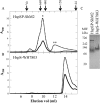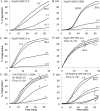In Vitro Structural and Functional Characterization of the Small Heat Shock Proteins (sHSP) of the Cyanophage S-ShM2 and Its Host, Synechococcus sp. WH7803
- PMID: 27643500
- PMCID: PMC5028025
- DOI: 10.1371/journal.pone.0162233
In Vitro Structural and Functional Characterization of the Small Heat Shock Proteins (sHSP) of the Cyanophage S-ShM2 and Its Host, Synechococcus sp. WH7803
Abstract
We previously reported the in silico characterization of Synechococcus sp. phage 18 kDa small heat shock protein (HspSP-ShM2). This small heat shock protein (sHSP) contains a highly conserved core alpha crystalline domain of 92 amino acids and relatively short N- and C-terminal arms, the later containing the classical C-terminal anchoring module motif (L-X-I/L/V). Here we establish the oligomeric profile of HspSP-ShM2 and its structural dynamics under in vitro experimental conditions using size exclusion chromatography (SEC/FPLC), gradient native gels electrophoresis and dynamic light scattering (DLS). Under native conditions, HspSP-ShM2 displays the ability to form large oligomers and shows a polydisperse profile. At higher temperatures, it shows extensive structural dynamics and undergoes conformational changes through an increased of subunit rearrangement and formation of sub-oligomeric species. We also demonstrate its capacity to prevent the aggregation of citrate synthase, malate dehydrogenase and luciferase under heat shock conditions through the formation of stable and soluble hetero-oligomeric complexes (sHSP:substrate). In contrast, the host cyanobacteria Synechococcus sp. WH7803 15 kDa sHSP (HspS-WH7803) aggregates when in the same conditions as HspSP-ShM2. However, its solubility can be maintained in the presence of non-ionic detergent Triton™X-100 and forms an oligomeric structure estimated to be between dimer and tetramer but exhibits no apparent inducible structural dynamics neither chaperon-like activity in all the assays and molar ratios tested. SEC/FPLC and thermal aggregation prevention assays results indicate no formation of hetero-oligomeric complex or functional interactions between both sHSPs. Taken together these in vitro results portray the phage HspSP-ShM2 as a classical sHSP and suggest that it may be functional at the in vivo level while behaving differently than its host amphitropic sHSP.
Conflict of interest statement
The authors have declared that no competing interests exist.
Figures






Similar articles
-
Multiple nanocages of a cyanophage small heat shock protein with icosahedral and octahedral symmetries.Sci Rep. 2021 Oct 25;11(1):21023. doi: 10.1038/s41598-021-00172-2. Sci Rep. 2021. PMID: 34697325 Free PMC article.
-
Analysis and phylogeny of small heat shock proteins from marine viruses and their cyanobacteria host.PLoS One. 2013 Nov 12;8(11):e81207. doi: 10.1371/journal.pone.0081207. eCollection 2013. PLoS One. 2013. PMID: 24265841 Free PMC article.
-
Formation of non-toxic Aβ fibrils by small heat shock protein under heat-stress conditions.Biochem Biophys Res Commun. 2013 Jan 25;430(4):1259-64. doi: 10.1016/j.bbrc.2012.12.059. Epub 2012 Dec 19. Biochem Biophys Res Commun. 2013. PMID: 23261462
-
Anti-aggregation activity of small heat shock proteins under crowded conditions.Int J Biol Macromol. 2017 Jul;100:97-103. doi: 10.1016/j.ijbiomac.2016.05.080. Epub 2016 May 24. Int J Biol Macromol. 2017. PMID: 27234495 Review.
-
The role of intrinsically disordered regions in the structure and functioning of small heat shock proteins.Curr Protein Pept Sci. 2012 Feb;13(1):76-85. doi: 10.2174/138920312799277875. Curr Protein Pept Sci. 2012. PMID: 22044147 Review.
Cited by
-
Effect of N-terminal region of nuclear Drosophila melanogaster small heat shock protein DmHsp27 on function and quaternary structure.PLoS One. 2017 May 16;12(5):e0177821. doi: 10.1371/journal.pone.0177821. eCollection 2017. PLoS One. 2017. PMID: 28520783 Free PMC article.
-
The growing world of small heat shock proteins: from structure to functions.Cell Stress Chaperones. 2017 Jul;22(4):601-611. doi: 10.1007/s12192-017-0787-8. Epub 2017 Mar 31. Cell Stress Chaperones. 2017. PMID: 28364346 Free PMC article. Review.
-
Oligomeric structure and chaperone-like activity of Drosophila melanogaster mitochondrial small heat shock protein Hsp22 and arginine mutants in the alpha-crystallin domain.Cell Stress Chaperones. 2017 Jul;22(4):577-588. doi: 10.1007/s12192-017-0784-y. Epub 2017 Apr 7. Cell Stress Chaperones. 2017. PMID: 28389817 Free PMC article.
-
Multiple nanocages of a cyanophage small heat shock protein with icosahedral and octahedral symmetries.Sci Rep. 2021 Oct 25;11(1):21023. doi: 10.1038/s41598-021-00172-2. Sci Rep. 2021. PMID: 34697325 Free PMC article.
-
α-Crystallin Domains of Five Human Small Heat Shock Proteins (sHsps) Differ in Dimer Stabilities and Ability to Incorporate Themselves into Oligomers of Full-Length sHsps.Int J Mol Sci. 2023 Jan 6;24(2):1085. doi: 10.3390/ijms24021085. Int J Mol Sci. 2023. PMID: 36674601 Free PMC article.
References
-
- Van Montfort R, Slingsby C, Vierling E. Structure and function of the small heat shock protein/alpha-crystallin family of molecular chaperones. Adv Protein Chem. 2001;59:105–56. Epub 2002/03/01. . - PubMed
-
- de Jong WW, Caspers GJ, Leunissen JA. Genealogy of the alpha-crystallin—small heat-shock protein superfamily. Int J Biol Macromol. 1998;22(3–4):151–62. - PubMed
MeSH terms
Substances
LinkOut - more resources
Full Text Sources
Other Literature Sources

